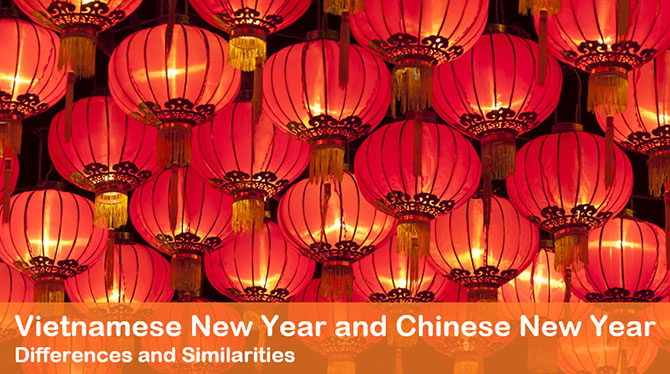What are the differences between the two celebrations? What do they have in common?
To us Westerners, Chinese New Year is often seen as the same everywhere, in any Asian country with Lunar Calendar, and to be honest it is not completely wrong! The general atmosphere is similar no matter if you celebrate it in China, Korea, Taiwan, Singapore or Vietnam.
After living in China for 3 years as V-Trust Sales Manager and 1 year in Vietnam as V-Trust Country Manager, I am happy to share my experience and feelings, even if, for sure, I don’t know everything and they may not be exhaustive.
Chinese New Year and the Vietnamese New Year (called Tết in Vietnam) actually have a lot in common.
What we can be sure of is that Lunar New Year holidays are always about dedicating time for family, gatherings, gifts and hoping for the best for the New Year to come. It’s the ‘super holiday’ of Asia; you should picture it as a mix of Christmas, New Year's Day, Thanksgiving (for our fellow US readers) and your birthday all rolled into one giant one week holiday
Both China and Vietnam follow the same calendar (5th of February in 2019, January the 25th in 2020 and February the 12th in 2021).
For both of them, it’s all about coming back home and spending time with the family. Ways to celebrate are also similar, with flower markets, dragon dances, orange trees, red envelopes filled with money for children, and firecrackers.
Some interesting differences exist, like… the Rabbit replaced with the Cat.
Food enjoyed during this special period is one of the biggest differences! In Vietnam, people would prepare sticky rice packed in plant leaves (Bánhchưng), green rice cakes, Vietnamese sausage (Giòchả) and candied fruits. I have never found such dishes on a Chinese table during the New Year.
Schedule is also different in Vietnam. On the first day, Vietnamese usually visit their parents on the husband’s side; on the second day they visit parents on the wife’s side; and lastly, they spend their third day of Tet visiting their teachers.
Another difference almost goes without saying: the name of both celebrations. While the New Year is called Spring festival (Chūnjié - 春節), it is called Tết in Vietnam, short for Tết Nguyên Đán - Feast of the First Morning of the First Day.
One of the last differences I noticed is the zodiac calendar. Both Chinese and Vietnamese lunar calendar are divided by periods of 12 years, with one animal for each year. The two countries share 10 of the zodiac calendar’s 12 signs—the rat, tiger, dragon, snake, horse, goat, monkey, rooster, dog and pig. But the Vietnamese replace the rabbit with the cat and the ox with the buffalo. When I told my Chinese peer about this finding, he thought this point was very interesting, and wanted to know the reason. However, I don’t know the exact reason neither, I guess these differences seem mainly due to legends and beliefs.
As you can see, both celebrations share a lot in common. But, once you come for business in Vietnam, don’t make the mistake of telling the Vietnamese they celebrate the Chinese New Year.
Generally speaking, always avoid speaking of Vietnamese culture and Chinese culture interchangeably, I made this mistake when arriving and learned my lesson very quickly! Vietnam has been influenced and dominated but never ever conquered by its northern neighbor. The Vietnamese are extremely sensitive to this and extremely proud to be independent. Their culture certainly shares some commonalities with China’s, but the two are not the same. You are now advised, don’t make the mistake!
Even better, if you want to show respect and knowledge, you can now refer to the Vietnamese New year as the Tết festival to your business partner. Why not even go so far as to learn a popular greeting: Chúc Mừng Năm Mới (Happy New Year).
All the best from Vietnam! V-Trust has local management and full time inspectors in the country, covering all manufacturing regions!
If you’re in need of any support in supplier evaluation or quality control services in Vietnam or other Asian countries, please feel free to contact us at vietnam@v-trust.com. We are always more than willing to answer questions, share insights or provide contacts to help you achieve your goals in Asia.
Top 3 sourcing channels in Vietnam
Sourcing from Vietnam: Pros and Cons
Vietnam and European Union Free Trade Agreement
Differences in Business Mentality between China and Vietnam
Best sourcing destinations: Vietnam or China?
5 Practical Tips on How to Source Furniture from Vietnam
A SWOT Analysis of Wood Furniture in Vietnam
Industry Geography of Vietnamese - developing supplier network




Discussion